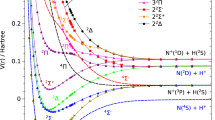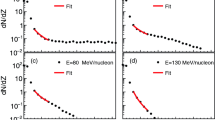Abstract
Using molecular dynamics simulations, binary collision density in a dense non-ideal gas with Lennard-Jones interactions is investigated. It is shown that the functional form of the dependence of collision density on particle density and collision diameter remains the same as that for an ideal gas. The temperature dependence of the collision density, however, has a very different form at low temperatures, where it decreases as temperature increases. But at higher temperatures the functional form becomes the same as that for an ideal gas.










Similar content being viewed by others
References
Moelwyn-Hughes, E.A.: Physical Chemistry, 2nd edn. Pergamon Press, New York (1961)
Tolman, R.C.: Statistical Mechanics with Applications to Physics and Chemistry, pp. 241–243. Chemical Catalog Company, New York (1927)
Silbey, R.J., Alberty, R.A.: Physical Chemistry. Wiley, New York (2001)
de Lima, E.F., Ho, T.S., Rabitz, H.: Laser-pulse photoassociation in a thermal gas of atoms. Phys. Rev. A 78, 063417 (2008)
Akkelin, S.V., Hama, Y., Karpenko, I.A., Sinyukov, Y.M.: Hydro-kinetic approach to relativistic heavy ion collisions. Phys. Rev. C 78, 034906 (2008)
Itakura, K., Morimatsu, O., Otomo, H.: Shear viscosity of a hadronic gas mixture. Phys. Rev. D 77, 014014 (2008)
Gaspard, P., Gilbert, T.: Heat conduction and Fourier’s law by consecutive local mixing and thermalization. Phys. Rev. Lett. 101, 020601 (2008)
Sentoku, Y., Kemp, A.J.: Numerical methods for particle simulations at extreme densities and temperatures: weighted particles, relativistic collisions and reduced currents. J. Comp. Phys. 227, 68466861 (2008)
Dunkel, J., Hänggi, P.: Relativistic Brownian motion: from a microscopic binary collision model to the Langevin equation. Phys. Rev. E 74, 051106 (2006)
Dunkel, J., Hänggi, P.: Relativistic Brownian motion. Phys. Rep. 471, 1–73 (2009)
Peano, F., Marti, M., Silva, L.O.: Statistical kinetic treatment of relativistic binary collisions. Phys. Rev. E 79, 025701(R) (2009)
Mohazzabi, P., Helvey, S.L., McCumber, J.: Maxwellian distribution in non-classical regime. Phys. A 316, 314–322 (2002)
Mohazzabi, P., Schmidt, J.R.: Maxwellian relaxation of elastic particles in one dimension. Am. J. Phys. 79, 861–866 (2011)
Silbey, R.J., Alberty, R.A.: Physical Chemistry. Wiley, New York (2001)
Liboff, R.L.: Kinetic Theory, 2nd edn. Wiley, New York (1998)
Miandehy, M., Modarress, H.: Equation of state for hard-spheres. J. Chem. Phys. 119, 2716–2719 (2003)
Kittel, C.: Introduction to Solid State Physics, 7th edn. Wiley, New York (1996)
Gould, H., Tobochnik, J.: An Introduction to Computer Simulation Methods, vol. 8, 2nd edn. Addison-Wesley, New York (1996)
Haile, J.M.: Molecular Dynamics Simulation. Wiley, New York (1992)
Reference [17], p. 23
This is because the fraction of total volume occupied by the hard spheres is \(\displaystyle \frac{\pi n}{6}\)
Gould, H., Tobochnik, J.: An Introduction to Computer Simulation Methods, 2nd edn. Addison-Wesley, New York (1996)
Herzfeld, K.F., Smallwood, H.: In: Taylor, H.S., Glasstone, S. (eds.) A Treatise on Physical Chemistry, vol. II, 3rd edn, p. 37. Van Nostrand, New York (1951)
Strictly speaking, \(-\epsilon \) is the potential energy of the system of two particles. However, without loss of generality, we can assume that particles \(i\) and \(j\) have, respectively, \(-\epsilon \) and zero potential energies
Pathria, R.K.: Statistical Mechanics. Pergamon Press, New York (1972)
Author information
Authors and Affiliations
Corresponding author
Rights and permissions
About this article
Cite this article
Mohazzabi, P. Binary Collision Density in a Non-Ideal Gas as a Function of Particle Density, Collision Diameter, and Temperature. J Stat Phys 169, 362–373 (2017). https://doi.org/10.1007/s10955-017-1868-x
Received:
Accepted:
Published:
Issue Date:
DOI: https://doi.org/10.1007/s10955-017-1868-x




